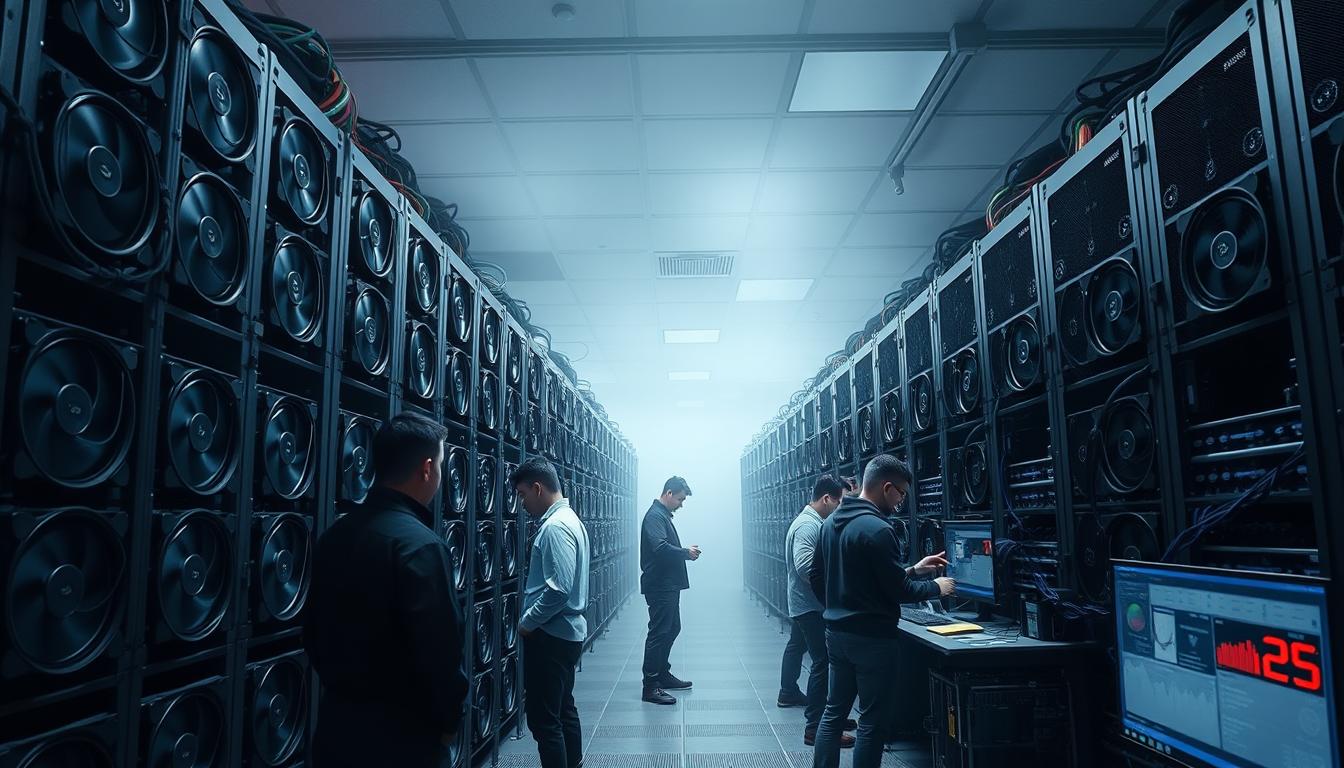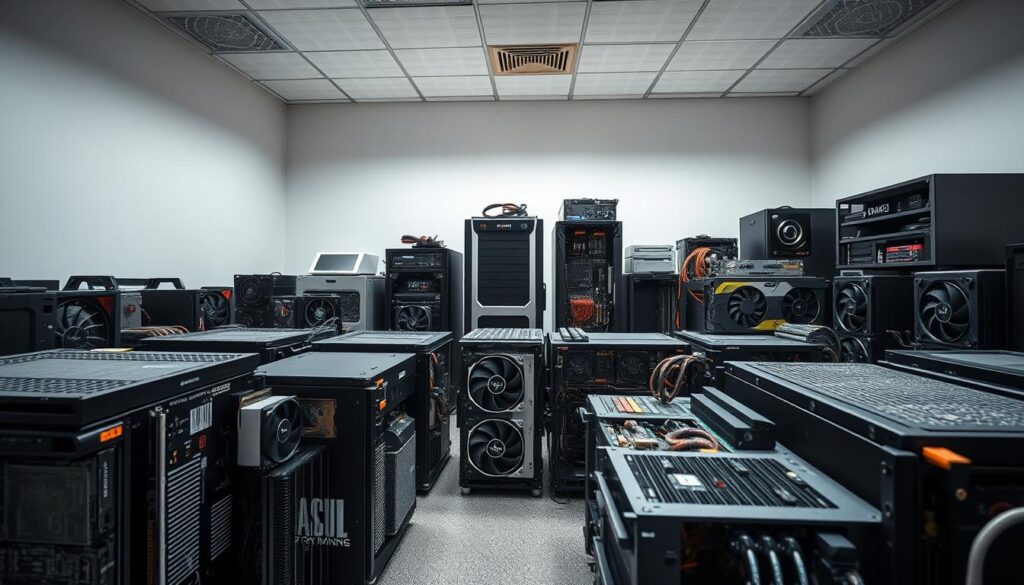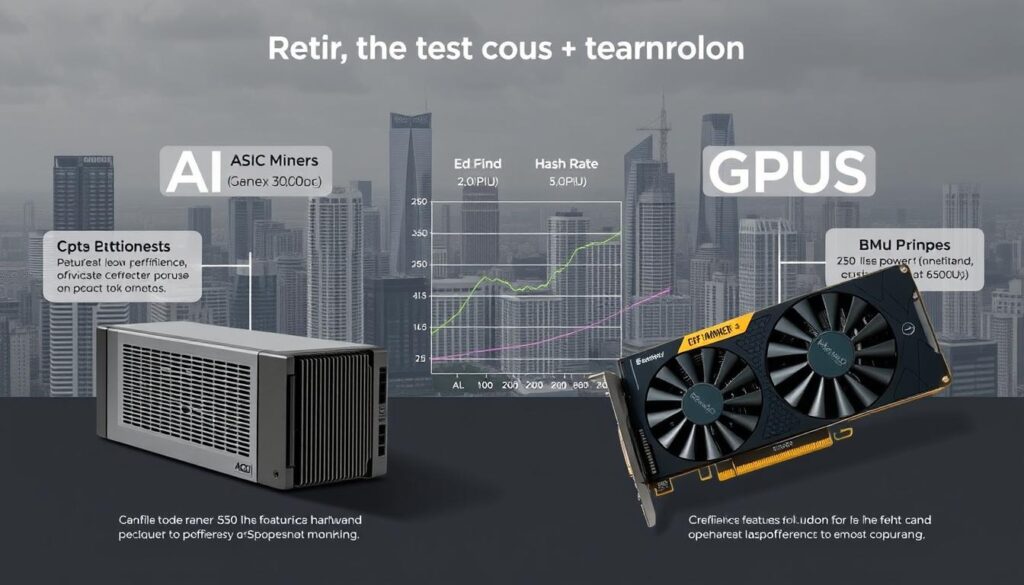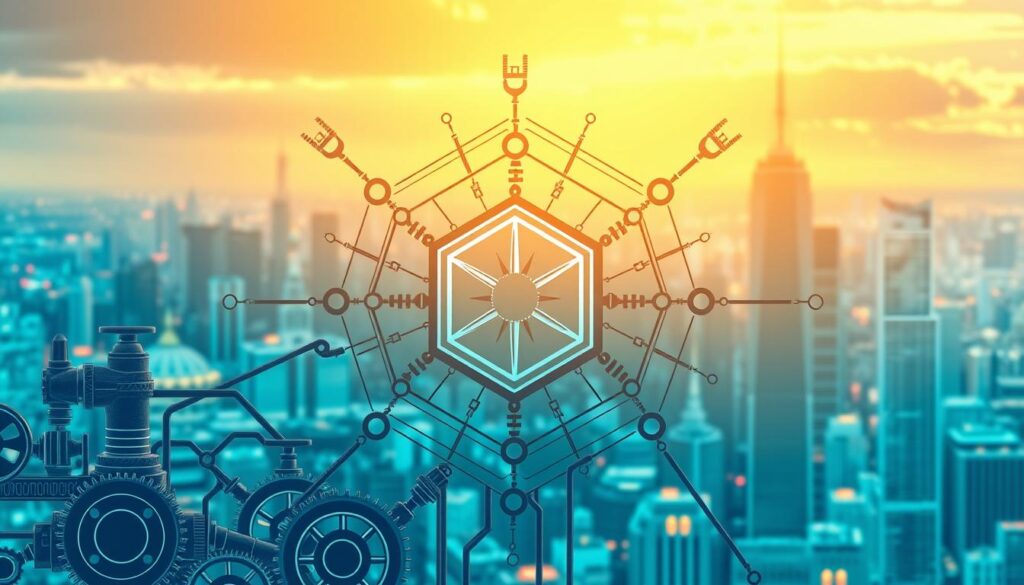Now Reading: A Comprehensive Cryptocurrency Mining Hardware Technology Guide
- 01
A Comprehensive Cryptocurrency Mining Hardware Technology Guide
A Comprehensive Cryptocurrency Mining Hardware Technology Guide

Bitcoin operates through a decentralized process where computers solve complex puzzles to validate transactions and create new coins. This system relies on specialized equipment capable of handling intense computational workloads. The right tools can mean the difference between profit and loss in this fast-paced field.
At its core, this activity ensures blockchain networks remain secure and functional. Every verified transaction strengthens the ecosystem, preventing fraud and maintaining trust among users. Over time, the machinery used for these tasks has evolved dramatically.
Early enthusiasts relied on basic computer processors, but today’s operations demand advanced application-specific integrated circuits (ASICs). These devices outperform older models but require careful financial planning due to upfront costs and energy consumption. Choosing the best option depends on factors like electricity rates and market trends.
The industry’s growth has reshaped global markets, influencing everything from energy demand to digital currency adoption rates. This guide will walk you through selecting equipment, optimizing setups, and analyzing expenses to help you navigate this competitive space.
Key Takeaways
- Specialized computers validate transactions and secure blockchain networks.
- Equipment costs range from affordable to premium, depending on performance needs.
- Modern ASIC devices outperform older CPU and GPU-based systems.
- Energy efficiency directly impacts profitability in large-scale operations.
- Market fluctuations require adaptable strategies for long-term success.
Introduction: Unveiling the World of Cryptocurrency Mining
At the heart of digital currency systems lies a process where participants validate transactions through computational efforts. This mechanism secures decentralized networks by converting raw power into verified entries on a shared ledger. Each solved puzzle adds a permanent block to the chain, creating an unbreakable record of exchanges.
Miners act as both auditors and architects, ensuring every transaction aligns with network rules while competing for rewards. Their work prevents double-spending and maintains the ledger’s accuracy without centralized oversight. Successful validators receive newly minted coins and fees, incentivizing continuous participation.
The rise of proof-of-work systems transformed this activity from casual experimentation to industrial-scale operations. Early adopters used everyday computers, but today’s landscape demands specialized tools and strategic energy management. Platforms offering advanced mining software now streamline these complex workflows, balancing efficiency with profitability.
As competition intensifies, the race to upgrade equipment reshapes global energy consumption patterns. This evolution highlights the delicate balance between innovation and sustainability in maintaining decentralized networks.
Understanding Bitcoin Mining and Blockchain Fundamentals
The Bitcoin blockchain relies on miners to process and secure transactions via mathematical problem-solving. These validators use the SHA-256 algorithm to convert transaction data into unique codes called hashes. Each solved puzzle confirms a block of exchanges, creating an immutable record visible to all network participants.

The Role of Hash Rate and Mining Difficulty
Hash rate determines how quickly a system can attempt solutions, measured in quintillions of calculations per second. Higher rates increase the chance of earning rewards but require more energy. The network automatically adjusts mining difficulty every 2,016 blocks to keep block creation at 10-minute intervals.
When more devices join the network, difficulty rises to prevent faster block times. This balancing act ensures stability even as computational power fluctuates globally. Miners must constantly upgrade equipment to stay competitive.
How Block Rewards and Halving Shape the Process
Successful miners receive block rewards—newly created coins plus transaction fees. These incentives drive participation but decrease over time. Every 210,000 blocks (about four years), rewards are cut in half—an event known as “halving.”
Halving controls Bitcoin’s supply, capping it at 21 million coins. This deflationary design increases scarcity, influencing market dynamics. As rewards diminish, transaction fees will become the primary motivation for validators.
Exploring the Core Concepts Behind Mining Technology
Every exchange on a decentralized ledger undergoes rigorous checks to maintain system integrity. This verification process prevents duplicate spending and ensures only legitimate actions enter the permanent record. Consensus mechanisms act as rulebooks, governing how participants agree on valid entries without centralized oversight.

Transaction Verification and Consensus Mechanisms
When users initiate transfers, those requests enter a waiting area called the mempool. Validators select which ones to process based on attached fees, creating a competitive marketplace for faster confirmations. High-priority exchanges typically clear first, while low-fee options may face delays during peak times.
Proof-of-Work remains the most widely recognized validation method. It requires solving cryptographic puzzles that demand significant energy but provide robust security. Alternative systems like Proof-of-Stake use coin ownership to determine validation rights, reducing power consumption.
| Consensus Type | Energy Use | Security Model | Decentralization Level |
|---|---|---|---|
| Proof-of-Work | High | Computational effort | Moderate |
| Proof-of-Stake | Low | Economic stake | Variable |
| Delegated PoS | Medium | Elected validators | Centralized |
These systems all share one goal: maintaining agreement across the network about which transactions count. Through cryptographic hashing and peer-to-peer communication, validators synchronize their records automatically. This eliminates the need for third-party auditors while keeping the system resistant to manipulation.
In-Depth cryptocurrency mining hardware technology guide
Modern validation systems demand tools engineered for extreme precision and relentless output. Application-Specific Integrated Circuits (ASICs) dominate this space, outperforming older solutions through purpose-built designs. These devices execute specific algorithms with surgical efficiency, slashing energy waste while boosting output.

Leading manufacturers like Bitmain and MicroBT set industry standards with models such as the Antminer S19 XP and Whatsminer M50S. These units achieve hash rates exceeding 100 TH/s while maintaining power efficiency below 30 joules per terahash. Thermal management innovations – including immersion cooling and optimized airflow designs – prevent overheating during continuous operation.
General-purpose graphics processors once powered early validation efforts but now serve niche roles. Their adaptability makes them viable for alternative digital assets requiring flexible computing approaches. However, ASICs remain unmatched for Bitcoin-related tasks due to their algorithm-specific optimization.
| Component | Hash Rate | Power Draw | Primary Use |
|---|---|---|---|
| ASIC Miner | 100+ TH/s | 3000-3500W | Bitcoin |
| High-End GPU | 50-100 MH/s | 200-300W | Altcoins |
Emerging chip architectures promise further efficiency gains through 5nm and 3nm transistor designs. These advancements could reduce energy demands by 40% while doubling computational density. As manufacturers push physical limits, liquid cooling systems and renewable energy integration become critical for sustainable operations.
Comparing ASIC Miners and Graphics Processing Units
Two distinct approaches dominate modern transaction validation systems: specialized machines and adaptable tools. Application-specific integrated circuits (ASICs) focus solely on executing one algorithm with unmatched precision. Graphics processing units (GPUs), however, balance versatility with raw computational power across multiple tasks.

Design and Efficiency: ASIC vs. GPU
ASIC miners excel in energy efficiency due to their single-purpose architecture. Devices like Bitmain’s Antminer S19 XP consume 29.5 joules per terahash – 80% less power than high-end GPUs. This optimization allows large-scale operations to maximize output while minimizing electricity costs.
| Device Type | Hash Rate | Power Use |
|---|---|---|
| ASIC Miner | 140 TH/s | 3010W |
| GPU (Nvidia 4090) | 120 MH/s | 450W |
Integrated circuits in ASICs eliminate unnecessary components found in general-purpose processing units. This streamlined design enables faster calculations but limits functionality beyond specific algorithms.
Adaptability and Multi-Currency Mining with GPUs
Graphics processing units shine when handling diverse validation tasks. Popular models like AMD’s RX 7900 XT can switch between algorithms, supporting newer digital assets that ASICs can’t process. This flexibility offers three key advantages:
- Easier transition during market shifts
- Higher resale value for gaming/rendering uses
- Reduced risk from algorithm changes
While GPUs consume more energy per task, their ability to mine multiple currencies balances long-term viability. Operators often combine several units into rigs, adjusting configurations as network demands evolve.
Key Components and Setup Considerations for Mining Hardware
Building a high-performance validation system requires careful selection of parts and strategic planning. Whether assembling GPU-based rigs or deploying ASIC units, each component impacts efficiency and long-term viability. Proper setup balances raw computational power with practical factors like noise control and thermal management.
Essential Elements of a Mining Rig
A GPU setup needs seven core parts: motherboard, processor, RAM, storage, power supply, risers, and multiple graphics cards. Each piece must work seamlessly to handle intense workloads. For example, a 1200W PSU can support six GPUs but requires precise voltage calibration.
| Component | GPU Rig | ASIC Unit |
|---|---|---|
| Power Supply | Modular 80+ Gold | Built-in 3600W |
| Noise Level | 65 dB | 90 dB |
| Cooling | Fans + Open Frame | Liquid Immersion |
Optimizing Energy Consumption and Cooling Solutions
Energy efficiency starts with selecting 80 Plus Platinum-rated power supplies, which waste 10% less electricity than standard models. Large operations often install industrial HVAC systems to maintain 68°F ambient temperatures. Three strategies reduce operational costs:
- Undervolting GPUs to cut power use by 20%
- Using immersion cooling for ASICs
- Installing soundproof enclosures in residential areas
Thermal pads and high-static pressure fans extend equipment lifespan by preventing overheating. Professional setups pair these with smart meters to track real-time energy consumption, enabling quick adjustments during peak rate hours.
Mining Pools and Solo Mining: Strategies for Success
Pooling resources has become a cornerstone strategy for consistent earnings in blockchain networks. By combining computational strength, participants increase their odds of solving complex puzzles while sharing profits. This collaborative approach contrasts with independent efforts, where success depends entirely on individual capacity.
Benefits of Joining a Mining Pool
Group efforts dramatically reduce income fluctuations compared to solo ventures. Participants receive smaller but more frequent payouts based on their contributed work. Popular platforms like F2Pool and AntPool handle reward distribution automatically, using transparent tracking systems.
| Reward Type | Fee Structure | Payout Frequency | Ideal For |
|---|---|---|---|
| Proportional | 1-2% pool fee | Daily | Small-scale miners |
| Pay-Per-Share | Fixed rate per share | Hourly | Consistent earners |
| Score-Based | Variable fees | Weekly | Long-term participants |
Most pools require simple account creation and worker configuration. Users monitor real-time statistics through dashboards showing hash rates and earnings. Larger networks often provide lower payout thresholds, making funds accessible faster.
While solo mining offers full reward retention, its viability depends on owning substantial computational power. For most, joining established groups balances risk and profitability effectively. Operators should compare pool locations, uptime guarantees, and community reviews before committing.
Managing Costs, Electricity, and Investment Risks
Financial planning separates thriving operations from failed ventures in blockchain validation. Upfront equipment expenses range from $700 for older ASIC models to $5,000 for cutting-edge units. GPU-based systems require $1,500+ for basic setups, creating significant entry barriers.
Ongoing energy consumption often outweighs initial investments. Operations in regions with $0.12/kWh rates face 65% higher expenses than those accessing $0.05/kWh industrial contracts. Renewable solutions like solar arrays reduce grid dependence but demand separate capital.
| Expense Type | ASIC Setup | GPU Rig |
|---|---|---|
| Hardware Cost | $3,200 | $1,800 |
| Monthly Power | $220 | $150 |
| Maintenance | $40 | $60 |
Three strategies protect against market shifts:
- Leasing equipment to avoid rapid depreciation
- Diversifying across multiple blockchain networks
- Using futures contracts to lock in energy rates
Break-even calculations must account for 18-24 month hardware lifespans. Tools like profitability calculators help forecast returns based on coin prices and difficulty trends. Commercial loans and equipment financing spread costs but add interest obligations.
Step-by-Step Guide to Configuring Your Mining Rig
Proper configuration separates efficient operations from costly mistakes. While ASIC units offer plug-and-play simplicity, GPU systems demand meticulous assembly. Each approach requires distinct steps to optimize performance and profitability.
Streamlined Setup for Different Systems
ASIC devices need three steps: connect power and internet, install firmware, then link to a validation pool. Most manufacturers provide web interfaces for pool settings and wallet integration. GPU rigs require OS installation, driver updates, and software like CGMiner before connecting to networks.
Key differences emerge in cooling solutions. ASICs often need external airflow management, while GPU arrays require open-frame designs with multiple fans. Both benefit from using a detailed setup guide to avoid common errors.
Final checks ensure stability. Monitor temperatures during initial runs and adjust power limits as needed. Regular firmware updates maintain compatibility with evolving network requirements. With these steps, systems can achieve peak efficiency within hours.















